Projected Losses of Ecosystem Services Incurred by Reserve Resources of Cultivated Land Development and Development Priority: A Case Study of Linzhou City in Henan Province, China
Abstract
:1. Introduction
2. Overview of the Research Area and Statistical Sources
2.1. Overview of the Research Area
2.2. Statistical Sources and Data Processing
3. Research Methods
3.1. Assessment of RRCL Tillability
3.2. Estimation of Ecological Regulation Services of Reserve Resources
3.2.1. Estimation of Water Conservation Services
3.2.2. Estimation of Carbon Sequestration and Oxygen Release
3.2.3. Estimation of Soil Retention
3.3. Prediction of Ecological Loss Incurred by RRCL Development
3.3.1. Prediction of Physical Loss of Ecosystem Services from RRCL Development
3.3.2. Prediction of Value Loss of Ecosystem Services Incurred by RRCL Development
3.4. Determination of the Priority of RRCL Development Based on Ecological Profit–Loss
4. Analysis of Results
4.1. Assessment Results of RRCL Tillability
4.2. Estimation Results of Physical Calculation of Ecosystem Regulation Services
4.3. Analysis of the Results of Predicted Loss of Ecosystem Services Incurred by RRCL Development
4.3.1. Analysis of the Results of the Predicted Physical Loss of Ecosystem Services Incurred by RRCL Development
4.3.2. Value of the Losses of Ecological Services Incurred by RRCL Development in Linzhou City
4.4. Priority of RRCL Development in Linzhou City
5. Discussions
6. Conclusions
- (1)
- First, this study established a system of assessment indicators of RRCL tillability based on natural, ecological, and social conditions to assess the tillability of grassland, saline–alkali land, sandy land, and bare land in Linzhou City so as to properly determine the scope of RRCL. Judging from the assessment results, there are 2233 hectares of tillable and reclaimable RRCL in total in Linzhou City, among which 2120 hectares are grassland (95%). With respect to the influencing range of assessment indicators, the major limiting factors of RRCL development in Linzhou City include the thin plough layer and the high gravel content. In addition, there are 6612.8 hectares of reclaimable RRCL, including artificial forest, grassland, garden, and pond, whose recovery is either enabled by engineering projects or to promptly take place. These results are obtained according to the Third National Land Resource Survey conducted in Linzhou City. Not all lands are suitable for development as cultivated land, and it is necessary to conduct a reasonable tillability evaluation before the development of RRCL. The purpose of this is to make the newly cultivated land have enough capacity to produce crops. Additionally, it can be profitable by obtaining enough economic remuneration to cover the cost of development, instead of making the development cost irrecoverable, resulting in a waste of development funds.
- (2)
- The results of calculation and comparison of regulating services from the RRCL development in Linzhou City indicated that the average ecosystem services of RRCL exceeded the level of cultivated land; the average water conservation from cultivable, recoverable and cultivated land reached 39.5, 8.2 and 7.07 mm, respectively; the average soil retention reached 101.25, 95.3 and 93.3 t·km-2·a-1, respectively, and the average carbon fixation and oxygen release reached 201.6, 196.6 and 171.8 t·km-2, respectively. From this result, it can be seen that the ecosystem services of RRCL are higher than those of cultivated land. Additionally, the development of RRCL will cause the loss of ecosystem services. Therefore, it is necessary to predict the loss of ecosystem services in the development of RRCL.
- (3)
- This study projected the total annual loss of ecosystem services incurred by RRCL development in Linzhou City based on the assessment of tillable RRCL and the estimation of ecosystem regulation services. The annual losses of ecosystem services for cultivable and reclaimable land included: water conservation of 701,600 and 74,600 m3, respectively; soil retention of 179.5 and 161.34 t, respectively; and carbon fixation and oxygen release of 667.4 and 1643.72 t, respectively. Each ecological service is priced based on the shadow project method and the market value method, and the total annual loss of ecosystem regulation services incurred by RRCL development in Linzhou City is measured to be RMB 15.7754 million. Specifically, the loss of cultivable reserve resources amounts to RMB 11.9107 million, that of reclaimable land amounts to RMB 3.8647 million, and the unit area losses of cultivable and reclaimable land amount to 0.53 and 0.06 (10,000 yuan/hm), respectively. The loss of ecosystem services per unit area is as follows: reclaimable land < cultivable land. Therefore, the development of reclaimable land has higher ecological suitability and lower ecosystem service losses. In fact, since a certain amount of human labor and capital has been invested in reclaimable land, the cost of developing reclaimable RRCL is lower than that of cultivable land and has a higher economic return.
- (4)
- Proper priority of development is determined according the ecological loss of various sorts of RRCL. In terms of the average value loss of ecological services incurred by varying types of RRCL development, pond < garden < artificial grassland < artificial forest < natural grassland < bare land. Hence, various sorts of RRCL should be developed in the decreasing order of losses. The development priority of RRCL in Linzhou City is determined by adjusting the ecological coefficient of the economic potential of RRCL development in each town. The results indicated that development priority is higher in eastern towns than in central and western towns, with Donggang and Hengshui having the highest priority and Shibanyan, Lingyang, and Chengguan having the lowest priority. When only considering ecological suitability, it is reasonable that land types with low ecological loss levels have higher development priorities. However, the factors considered in actual development also include the development potential of RRCL. Therefore, this paper corrects the ecological coefficient of the development potential of RRCL. This will make up for the shortcoming of only focusing on the economic potential and ignoring ecological suitability in determining the priority of RRCL development. Additionally it will make the priority of RRCL development meet the economic potential and ecological suitability at the same time.
Author Contributions
Funding
Institutional Review Board Statement
Informed Consent Statement
Data Availability Statement
Acknowledgments
Conflicts of Interest
References
- Zhang, F.; Guo, L.; Guan, X.; Shi, J.; Xu, Y.; Zhang, J. Study on the Evaluation of the Arable Land from the View of Ecological Security. China Land Sci. 2009, 23, 4–8. [Google Scholar]
- Zhang, D.; Zhang, F.; An, P.; Liu, L. Potential Economic Supply of Arable Land in China. Resour. Sci. 2004, 26, 46–52. [Google Scholar]
- Song, W.; Pijanowski, B.C. The effects of China’s cultivated land balance program on potential land productivity at a national scale. Appl. Geogr. 2014, 46, 158–170. [Google Scholar] [CrossRef]
- Wang, W.; Yu, Q.; Zhao, D. On explanation and practice of dynamic overall equilibrium of cultivated land. China Popul. Resour. Environ. 2001, 3, 64–69. [Google Scholar]
- Zhou, H. Challenges and countermeasures for policy implementation of balance of cultivated land requisition and compensation in China. Sci. J. Intell. Syst. Res. 2021, 3, 419–424. [Google Scholar]
- Yang, Z.; Xunhuan, L.; Yansui, L. Cultivated land protection and rational use in China. Land Use Policy 2021, 106, 105454. [Google Scholar]
- Wu, Y.; Shan, L.; Guo, Z.; Peng, Y. Cultivated land protection policies in China facing 2030: Dynamic balance system versus basic farmland zoning. Habitat Int. 2017, 69, 126–138. [Google Scholar] [CrossRef]
- Kong, X. Analysis of the current problems faced by farmland protection and research on countermeasures. China Land 2020, 12, 4–7. [Google Scholar]
- Gao, X.; Wu, K.; Yun, W.; Tang, C.; Xu, S.; Ma, Z. Analysis on county based reserved resource for cultivated land and quality-quantity requisition-compensation balance in planning period. Editor. Off. Trans. Chin. Soc. Agric. Eng. 2015, 31, 213–219. [Google Scholar]
- Sun, R.; Sun, P.; Wu, J.; Zhang, J. Effectiveness and Limitations of Cultivated Land Requisition-compensation Balance Policy in China. China Popul. Resour. Environ. 2014, 24, 41–46. [Google Scholar]
- Wu, J.; Zhang, T. Evaluation method of reserve resources for Cultivated land and its application. J. Agrotech. Econ. 1999, 3, 35–36. [Google Scholar]
- Guan, X.; Zhang, F.; Li, L.; Guo, L.; Shao, Z. Suitability evaluation of reserve resources of cultivated land development in Beijing. Editor. Off. Trans. Chin. Soc. Agric. Eng. 2010, 26, 304–310. [Google Scholar]
- Zhang, G.; Wu, Y.; Zhao, Y. Physical suitability evaluation of reserve resources of cultivated land in China based on SOTER. Trans. Chin. Soc. Agric. Eng. 2010, 26, 1–8. [Google Scholar]
- Xiao, L.; Yang, X.; Chen, S.; Chai, H. Suitability assessment of reserve cultivated land resources south of the Yangtze River. Resour. Sci. 2015, 37, 2030–2038. [Google Scholar]
- Zhang, Z.; Shi, Z. Investigation and Evaluation of Cultivated Land Reserve Resources in Jingning county Based on GIS. J. Anhui Agric. Sci. 2020, 48, 70–75. [Google Scholar]
- Ren, J.; Fang, B.; Xu, S. Study on Spatial Distribution and Impact Factors of Reserved Cultivated Land Resources in the Middle and Lower Reaches of Yangtze River. China Land Sci. 2016, 30, 71–79. [Google Scholar]
- Yan, C.; Yuan, L.; Li, M. Study on Space Differential of Reserving Cultivatable Land Resources in Jiangsu Province and the Model of Exploiting Priority Scheduling. Geogr. Geo Inf. Sci. 2005, 21, 58–61. [Google Scholar]
- Yi, L.; Zhang, Z.; Wang, X.; Liu, B.; Zuo, L.; Zhao, X.; Wang, J. Spatial-temporal change of major reserve resources of cultivated land in China in recent 30 years. Trans. Chin. Soc. Agric. Eng. 2013, 29, 1–12. [Google Scholar]
- Huang, H.; Hu, Y. Reserving cultivatable land resources exploitation combination based on two-dimensional graph theory clustering method in Yangshan County. Econ. Geogr. 2013, 33, 139–143. [Google Scholar]
- Yang, Y.; Shi, Y.; Sun, T.; Meng, D.; Bu, C.; Wang, X. Spatial Clustering-based Model of Exploitation Combination for Reserved Cultivated Land Resources in Tibet. Trans. Chin. Soc. Agric. Mach. 2016, 47, 239–247. [Google Scholar]
- Zhou, H.; Lei, G.; Yang, X.; Zhang, K. Utilization Zoning of Reserve Resources for Cultivated Land Based on Two-dimensional Graph Theory Clustering Method at County Scale. Trans. Chin. Soc. Agric. Mach. 2017, 48, 116–124. [Google Scholar]
- Jiang, N.; Zhang, L.; Zhao, H.; Gong, L. Physical suitability evaluation and potential development of reserve cultivated land resources in Songnen plain. Chin. J. Agric. Resour. Reg. Plan. 2019, 40, 15–25. [Google Scholar]
- Sun, P.; Gai, Z.; Zhang, J. Investigation evaluation and supplementary cultivated land potential under county level. Chin. J. Agric. Resour. Reg. Plan. 2017, 38, 145–152. [Google Scholar]
- Ye, D.; Wu, K.; Liu, P. Developmental potentiality evaluation of cultivated land reserve in Jingtai based on normal cloud and entropy weight. Chin. J. Agric. Resour. Reg. Plan. 2016, 37, 22–28. [Google Scholar]
- Chen, C.; Cao, L. Analysis on the development and utilization of reserve sources of cultivated land of low hilly woodland area in central section five provinces. Chin. J. Agric. Resour. Reg. Plan. 2013, 34, 38–43. [Google Scholar]
- Xiangbin, K. China must protect high-quality arable land. Nature 2014, 506, 7. [Google Scholar]
- Meng, M.; Fan, W. Research on the Layout of the Reserve Resources of Xinjiang Cultivated Land Based on Water Resources Carrying Capacity. China Rural. Water Hydropower 2020, 4, 82–86. [Google Scholar]
- Liu, X.; Cai, Z.; Xu, Y.; Zheng, H.; Wang, K.; Zhang, F. Suitability Evaluation of Cultivated Land Reserved Resources in Arid Areas Based on Regional Water Balance. Water Resour. Manag. 2022, 36, 1463–1479. [Google Scholar] [CrossRef]
- Gao, X.; Wu, K.; Zhou, N. Ecological sensitivity and space utilization of reserve resources of cultivated land in Jingtai county. Chin. J. Agric. Resour. Reg. Plan. 2020, 41, 43–51. [Google Scholar]
- Jia, S.; Li, J.; Xie, D.; Fang, X. Study on the Ecology Security Research of Cultivated Land and its Reserve Resources in Balinyouqi of Inner Mongolia Autonomous Region. Chin. J. Soil Sci. 2016, 47, 777–782. [Google Scholar]
- Zhang, X.; Zhang, J.; Wu, k.; Li, J. Quality Evaluation and Relevant Temporal Development of Reserve Cultivated Land Resources in Huailai County, Hebei Province. Chin. J. Soil Sci. 2018, 49, 1041–1047. [Google Scholar]
- Ecology and Nature Conservation institute, Chinese Academy of Forestry. Specifications for Assessing the Functionality of Forest Ecosystem Services in China; Ecology and Nature Conservation Institute, Chinese Academy of Forestry: Beijing, China, 2020; GB/T 38582-2020. [Google Scholar]
- Sui, Y.; Xu, L. The policy orientation of land space governance is adjusted by the "three adjustments" technology adjustment. China Land 2019, 12, 24–27. [Google Scholar]
- Department of Cadastral Management Ministry of Land and Resources; China Academy of Land Survey and Planning. Technical Regulations for Investigation and Evaluation of Cultivated Land Reserve Resources; Department of Cadastral Management Ministry of Land and Resources; China Academy of Land Survey and Planning: Beijing, China, 2003; pp. 1–36. TD/T 1007-2003.
- Department of Soil and Water Conservation of the Ministry of Water Resources; Monitoring Center of Soil and Water Conservation of the Ministry of Water Resources; Yellow River Water Conservancy Commission Yellow River Upper and Middle Reaches Management Bureau. Comprehensive Management of Soil and Water Conservation Technical Specifications Of Slope Arable Land Treatment Technology; Department of Soil and Water Conservation of the Ministry of Water Resources; Monitoring Center of Soil and Water Conservation of the Ministry of Water Resources; Yellow River Water Conservancy Commission Yellow River Upper and Middle Reaches Management Bureau: Beijing, China, 2008; GB/T 16453.1-2008.
- Ouyang, Z.; Wang, X.; Miao, H. A primary study on Chinese terrestrial ecosystem services and their ecological-economic values. Acta Ecol. Sin. 1999, 19, 19–25. [Google Scholar]
- Costanza, R.; d’Arge, R.; Groot, R.d.; Farber, S.; Grasso, M.; Hannon, B.; Limburg, K.; Naeem, S.; O’Neill, R.V.; Paruelo, J.; et al. The value of the world’s ecosystem services and natural capital. Ecol. Econ. 1998, 387, 253–260. [Google Scholar] [CrossRef]
- Howe, C.; Suich, H.; Vira, B.; Mace, G.M. Creating win-wins from trade-offs? Ecosystem services for human well-being: A meta-analysis of ecosystem service trade-offs and synergies in the real world. Glob. Environ. Change 2014, 28, 263–275. [Google Scholar] [CrossRef] [Green Version]
- Board, M.A. Millennium ecosystem assessment. WA DC New Isl. 2005, 13, 520. [Google Scholar]
- Zhou, B.; Zhu, J.; Lu, P.; Huang, Z. The service function value assessment analysis of urban wetland ecosystem--A case study of Xi’an Chan-Ba wetland. In Proceedings of the IOP Conference Series: Earth and Environmental Science, Banda Aceh, Indonesia, 26–27 September 2018; p. 012114. [Google Scholar]
- Xiao, H.; McDonald-Madden, E.; Sabbadin, R.; Peyrard, N.; Dee, L.E.; Chadès, I. The value of understanding feedbacks from ecosystem functions to species for managing ecosystems. Nat. Commun. 2019, 10, 3901. [Google Scholar] [CrossRef] [Green Version]
- Sao, L.; Xin, Y.; Liang, R.; Jian, N.; Yuan, X.; Zheng, Z. Forest ecosystem service and it’s evaluation in China. Chin. J. Appl. Ecol. 2005, 8, 1531–1536. [Google Scholar]
- Hu, X.; Song, C.; Fan, X.; Xiao, Y.; Xu, W.; Ouyang, Z. Main Regulation Services and Value Assessment of Shrub Ecosystem in China. J. Beijing For. Univ. (Soc. Sci.) 2021, 20, 58–64. [Google Scholar]
- Wang, Y.; Ye, A.; Qiao, F. Review on Connotation and Estimation method of Water Conservation. South North Water Transf. Water Sci. Technol. 2021, 19, 1041–1071. [Google Scholar]
- Chen, D.; Yu, X.; Liao, B. Analysis on the Function of Conservation Water of Chinese Forest Ecosystem. World For. Res. 2005, 1, 49–54. [Google Scholar]
- Sharp, R.; Tallis, H.; Ricketts, T.; Guerry, A.; Wood, S.; Chaplin-Kramer, R.; Nelson, E.; Ennaanay, D.; Wolny, S.; Olwero, N. InVEST Version 3.2. 0 User’s Guide. In The Natural Capital Project; The Nature Conservancy, and World Wildlife Fund: Vaud, Switzerland, 2015. [Google Scholar]
- Xu, J.; Xiao, Y.; Xie, G.; Wang, S.; Zhu, W. Spatiotemporal analysis of water supply service in the Dongjiang Lake Basin. Acta Ecol. Sin. 2016, 36, 4892–4906. [Google Scholar]
- Pan, T.; Wu, S.; Dai, E.; Liu, Y. Spatiotemporal variation of water source supply service in Three Rivers Source Area of China based on InVEST model. Chin. J. Appl. Ecol. 2013, 24, 183–189. [Google Scholar]
- Yang, J.; Xie, B.; Zhang, D. Spatio-temporal variation of water yield and its response to precipitation and land use change in the yellow river Basin based on InVEST model. Chin. J. Appl. Ecol. 2020, 31, 2731–2739. [Google Scholar]
- Li, Y.; Liu, W.; Feng, Q.; Zhu, M.; Yang, L.; Zhang, J. Quantitative Assessment for the Spatiotemporal Changes of Ecosystem Services, Tradeoff–Synergy Relationships and Drivers in the Semi-Arid Regions of China. Remote Sens. 2022, 14, 239. [Google Scholar] [CrossRef]
- Zhang, L.; Dawes, W.; Walker, G. Response of mean annual evapotranspiration to vegetation changes at catchment scale. Water Resour. Res. 2001, 37, 701–708. [Google Scholar] [CrossRef]
- Zhou, W.; Liu, G.; Pan, J.; Feng, X. Distribution of available soil water capacity in China. J. Geogr. Sci. 2005, 15, 3–12. [Google Scholar] [CrossRef]
- Wang, Y.; Dai, E.; Ma, L.; Yi, L. Spatiotemporal and influencing factors analysis of water yield in the Hengduan Mountain region. J. Nat. Resour. 2020, 35, 371–386. [Google Scholar]
- Gattuso, N.G.J.-P.; Middelburg, J.J. Oxygen production and carbon fixation in oligotrophic coastal bays and the relationship with gross and net primary production. Aquat. Microb. Ecol. 2008, 52, 119–130. [Google Scholar]
- Zhu, W.; Pan, Y.; Zhang, J. Estimation of net primary productivity of Chinese terrestrial vegetation based on remote sensing. Chin. J. Plant Ecol. 2007, 31, 413–424. [Google Scholar]
- Wengquan, Z. Estimation of net primary productivity of Chinese terrestrial vegetation based on remote sensing and its relationship with global climate change. Ph.D. Thesis, Beijing Normal University, Beijing, China, 2005. [Google Scholar]
- Liu, Y.; Zhao, W.; Jia, L. Soil Conservation Service: Concept, Assessment and outlook. Acta Ecologica. Sin. 2019, 39, 432–440. [Google Scholar]
- Cai, C.; Ding, S.; Shi, Z.; Huang, L.; Zhang, G. Study of Applying USLE and Geographical Information System IDRISI to Predict Soil Erosion in Small Watershed. J. Soil Water Conserv. 2000, 14, 19–24. [Google Scholar]
- Lai, M.; Wu, S.; Dai, E.; Yi, Y.; Zhao, D. The Indirect Value of Ecosystem Services in the Three-River Headwaters Region. J. Nat. Resour. 2013, 28, 38–50. [Google Scholar]
- Zhang, X. Analysis of soil nutrient status in Anyang City. Agric. Henan 2014, 2, 24–25, 27. [Google Scholar]
- Zhang, G.; Zhang, B.; Wang, H.; Zhang, H.; Wang, Y. Soil Physical and Chemical Properties in Main Maize Area of Henan Province. Chin. Agric. Sci. Bull. 2016, 32, 92–96. [Google Scholar]
- Ding, C.; Chai, H.; Diao, X. International practice and experience of carbon tax collection and management. Financ. Perspect. J. 2021, 9, 66–70. [Google Scholar]
- Ma, G.; Yu, F.; Wang, J.; Zhou, X.; Yuan, J.; Mo, X.; Zhou, Y.; Yang, W.; Peng, F. Measuring gross ecosystem product (GEP) of 2015 for terrestrial ecosystems in China. China Env. Ment. Sci. 2017, 37, 1474–1482. [Google Scholar]
- Wang, D.; Wang, X.; Li, Y. Practice experience of carbon tax in foreign countries and its implication for China. China Popul. Resour. Environ. 2018, 28, 20–23. [Google Scholar]
- Cumming, G.S.; Buerkert, A.; Hoffmann, E.M.; Schlecht, E.; Von Cramon-Taubadel, S.; Tscharntke, T. Implications of agricultural transitions and urbanization for ecosystem services. Nature 2014, 515, 50–57. [Google Scholar] [CrossRef]
- Lu, D.; Wang, Y.; Yang, Q.; He, H.; Su, K. Exploring a moderate fallow scale of cultivated land in China from the perspective of food security. Int. J. Environ. Res. Public Health 2019, 16, 4329. [Google Scholar] [CrossRef] [Green Version]
- Nowak-Olejnik, A.; Mocior, E.; Hibner, J.; Tokarczyk, N. Human perceptions of cultural ecosystem services of semi-natural grasslands: The influence of plant communities. Ecosyst. Serv. 2020, 46, 101208. [Google Scholar] [CrossRef]
- Liu, C.; Wan, Y.; Jing, S. Price Estimation Methods and Real Growth Measures for Ecosystem Service. Ecol. Econ. 2021, 37, 143–152. [Google Scholar]
- Mao, X.; Zhong, Y.; Zhang, S. Conception, theory and mechanism of eco-compensation. China Popul. Resour. Environ. 2002, 12, 40–43. [Google Scholar]
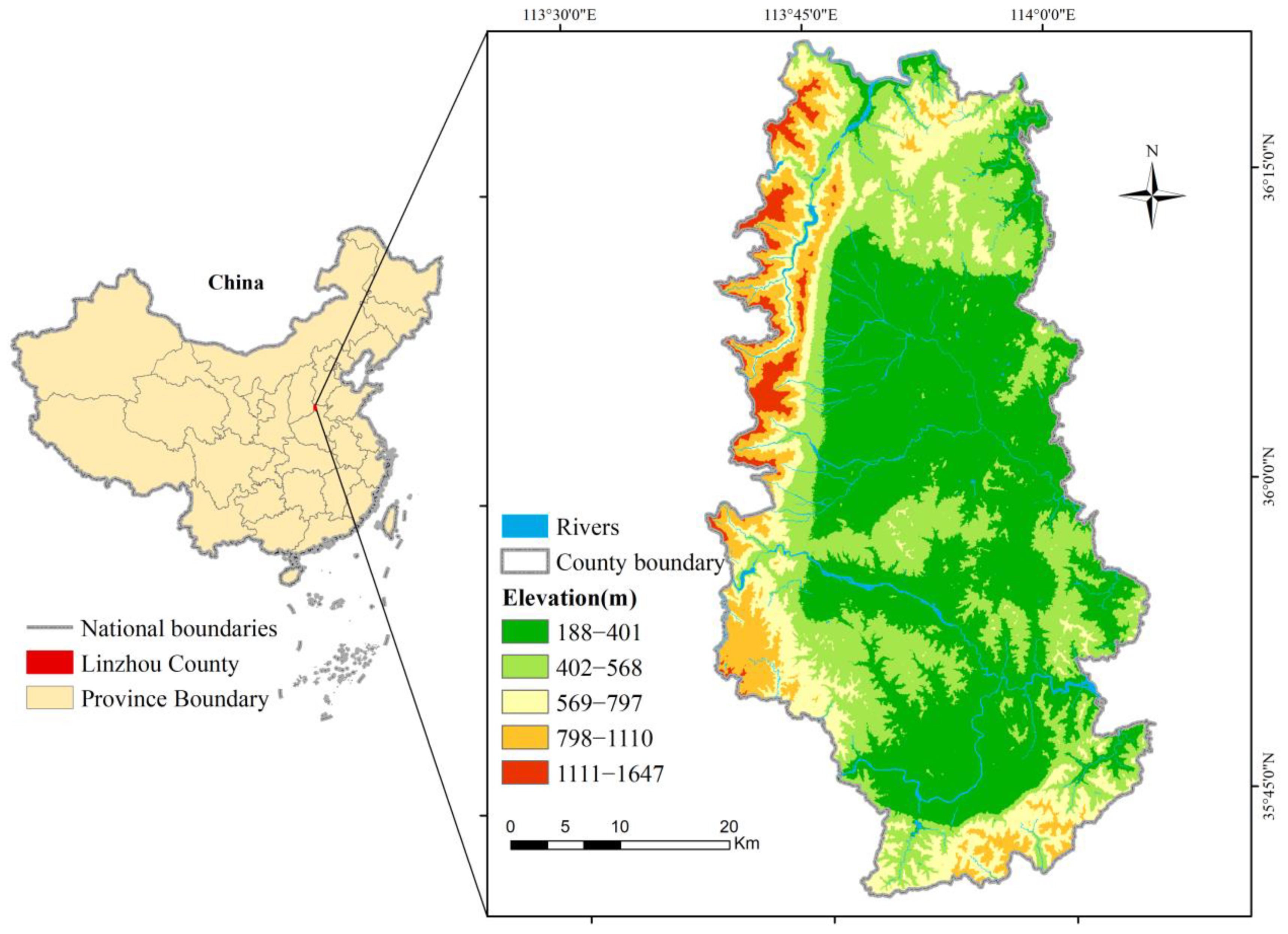
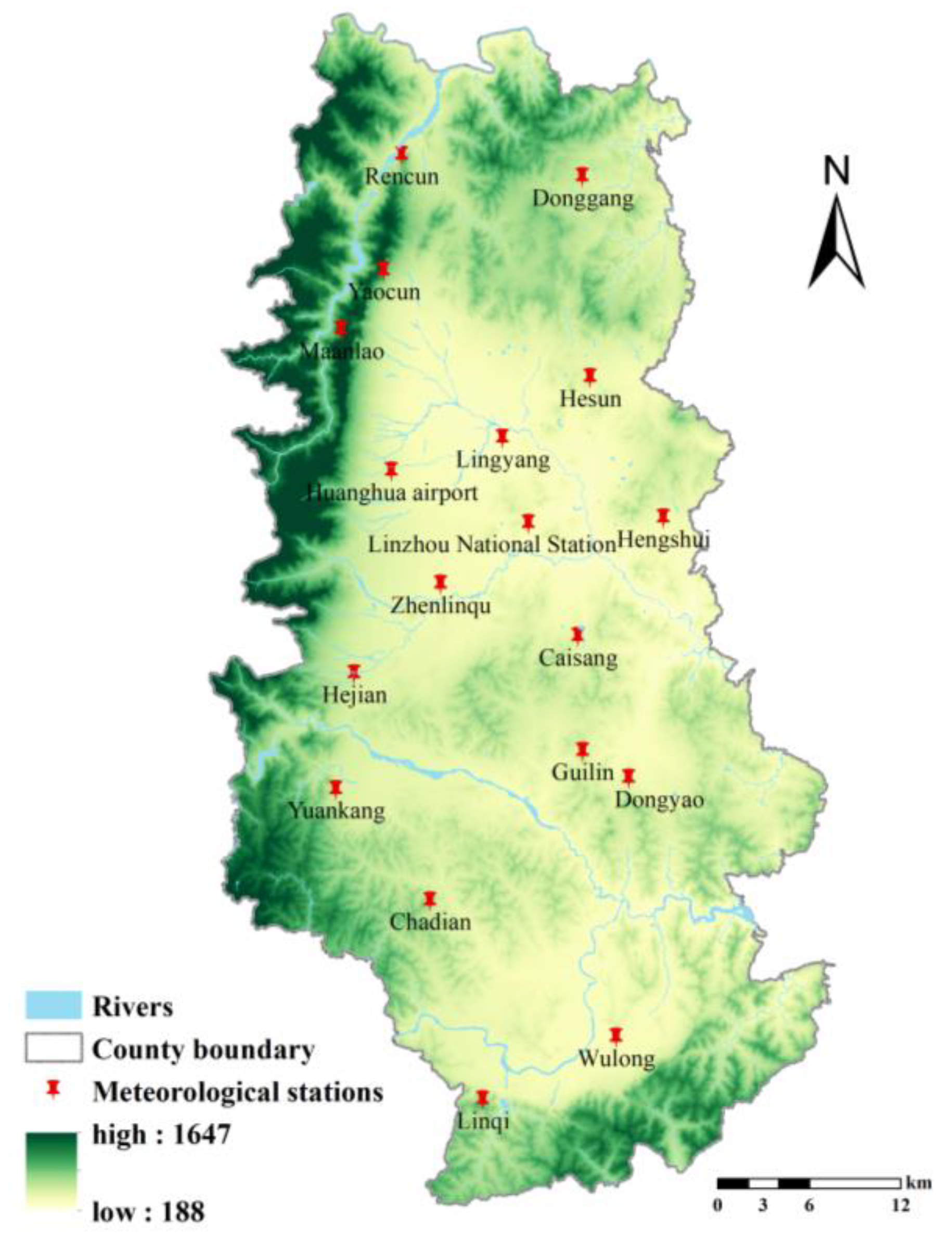
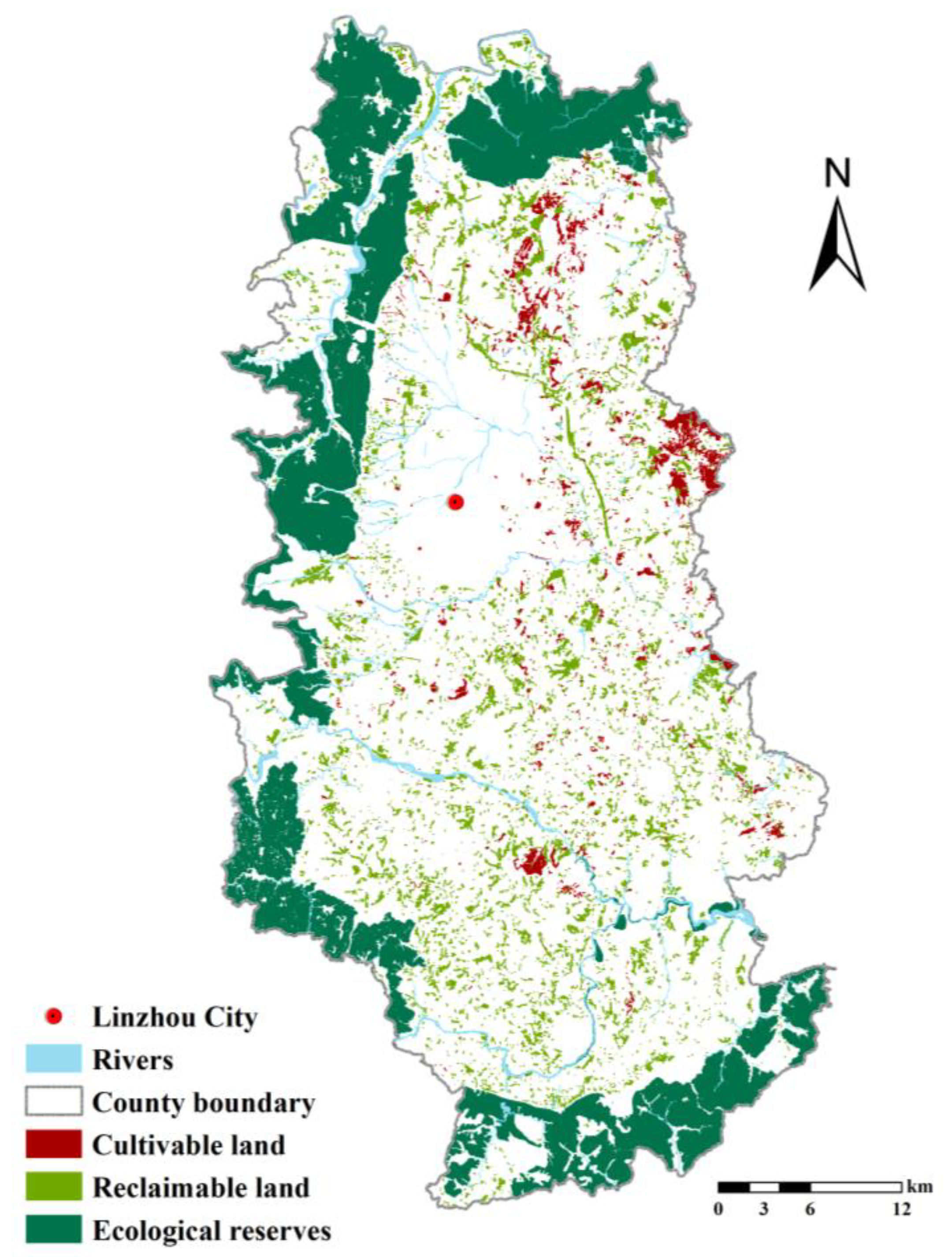
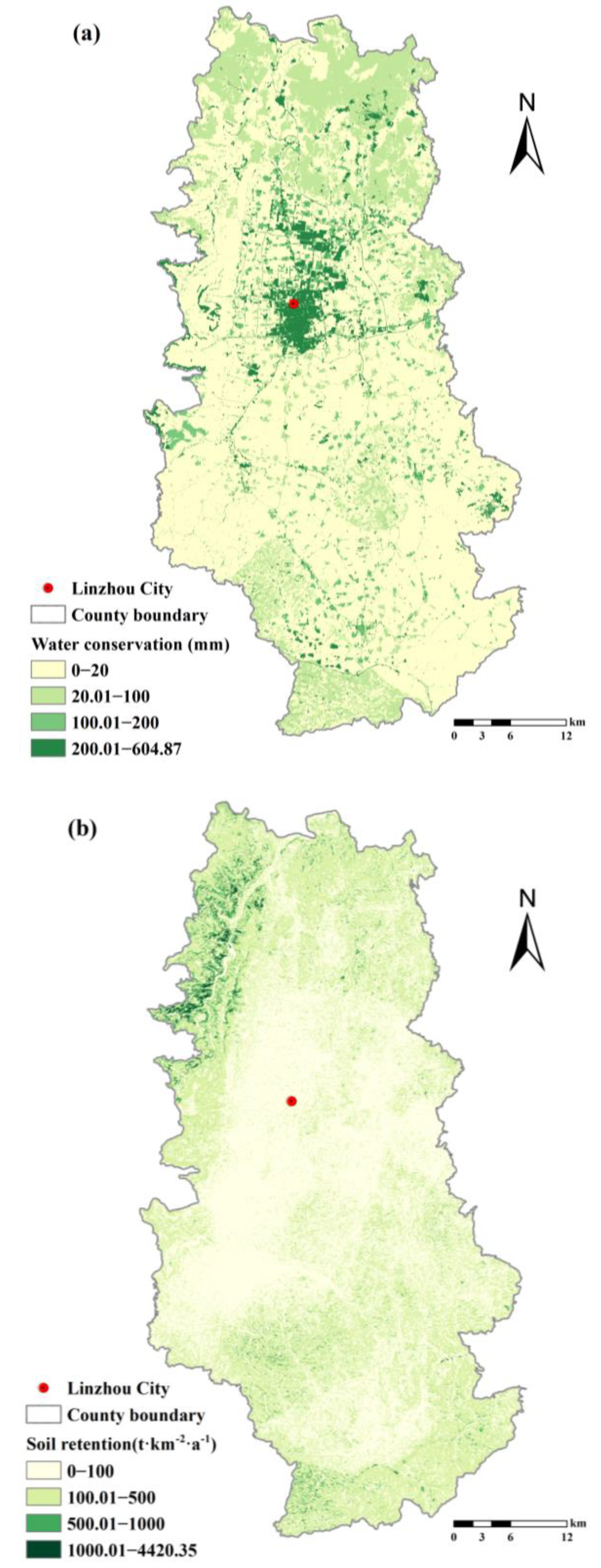
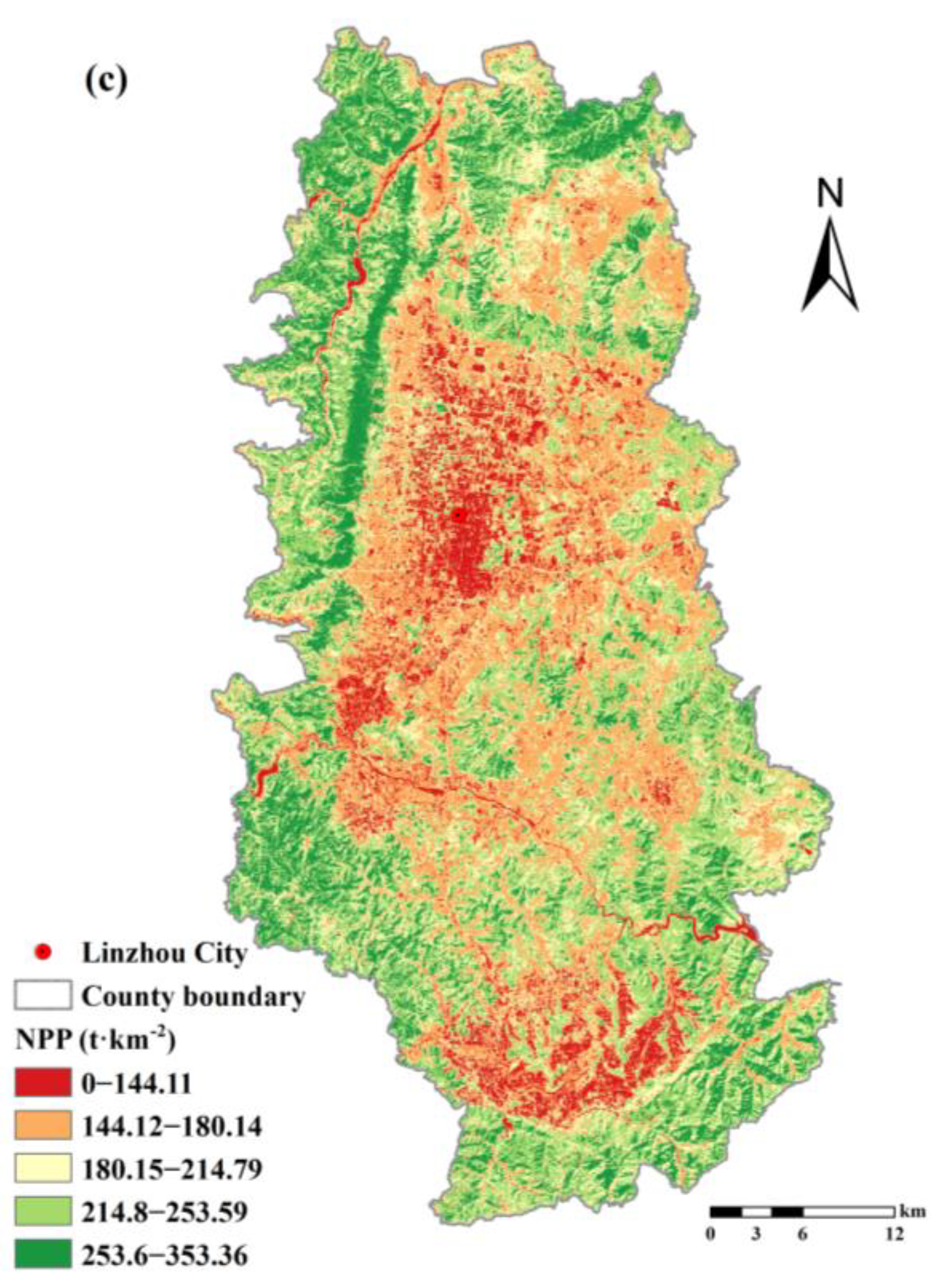

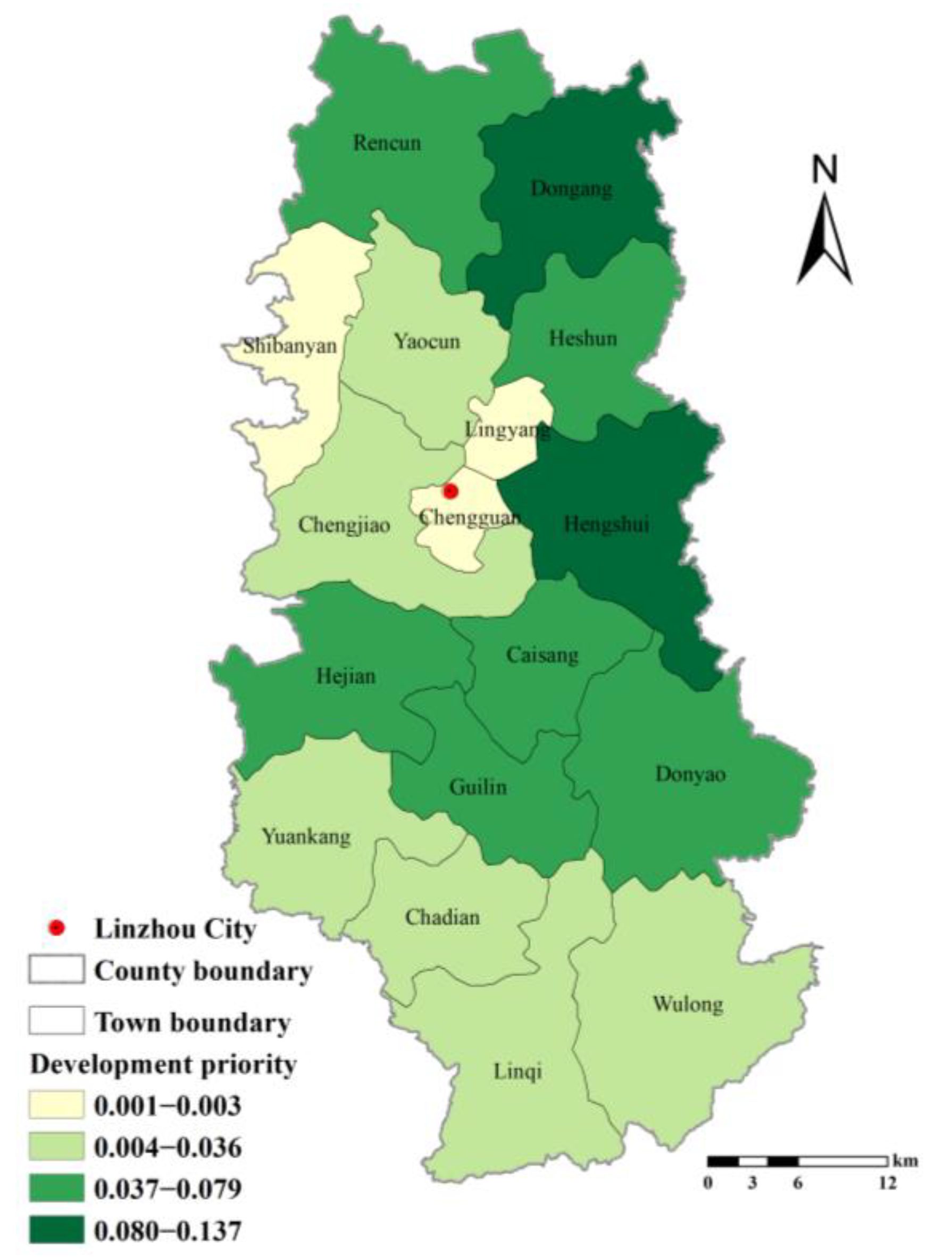
| Types of Data | Sources of Data | Format of Data |
|---|---|---|
| Data on the land use in 2020 | Third National Land Resource Survey conducted in Linzhou City | Vector |
| DEM data | Resource and Environment Sciences and Data Center (http://www.resdc.cn, accessed on 25 May 2022) | Raster (30 m × 30 m) |
| Soil data | Scientific Data Center in Cold and Arid Regions (http://westdc.westgis.ac.cn/, accessed on 25 May 2022) | Raster (1 km × 1 km) |
| Data on China’s county-level administrative boundary in 2015 | Resource and Environment Sciences and Data Center (http://www.resdc.cn, accessed on 25 May 2022) | Vector |
| NDVI data in 2020 | TOA image collection from the Landsat 8 Satellite (https://earthengine.google.com, accessed on 25 May 2022) | Raster (30 m × 30 m) |
| Meteorological data of Linzhou City in 2020 (daily temperature, daily precipitation) | Linzhou Fengyun Meteorological Development Center | Table |
| Evapotranspiration data | Dataset on the Global Potential Evapotranspiration and Global Aridity Index (https://cgiarcsi.community/data/global-aridity-and-pet-database/, accessed on 25 May 2022) | Raster (90 m × 90 m) |
| Data on the red line of ecosystems and the boundary of urban development | Territorial and spatial planning of Anyang City | Vector |
| Date on the solar radiation | NASA MODIS (https://ladsweb.modaps.eosdis.nasa.gov/, accessed on 25 May 2022) | Raster (1 km × 1 km) |
| Class I | Classification in the Study (Class II) | Classification in the Third National Land Resource Survey |
|---|---|---|
| Reclaimable land | Artificial forest | Shrub |
| Arbor forest | ||
| Other forests | ||
| Garden | Orchard | |
| Other gardens | ||
| Pond | Pond | |
| Breeding pond | ||
| Artificial grassland | Artificial pasture | |
| Other grasslands | ||
| Cultivable land | Natural grassland | Waste grassland |
| Other grasslands | ||
| Bare land | Idle land | |
| Bare land | ||
| Naked rocky and gravel land | ||
| Sandy land |
| Criterion Layer | Assessment Indicator | Assessment Criterion | |
|---|---|---|---|
| Tillable | Untillable | ||
| Natural condition | Annual temperature > 10 °C | >1800 °C | <1800 °C |
| Annual precipitation | >400 mm | <400 mm and without irrigation conditions | |
| Slope | <25° | ≥25° | |
| Elevation | <1500 m | ≥1500 m | |
| Plough layer | Soil texture | Clayey, loamy, sandy | Gravel content > 30% |
| Plough layer obstacle | None | Thin soil body and shallow lithoidal texture | |
| Ecological condition | Ecological effect | Exterior to the ecological red line | Within the ecological red line |
| Social condition | Retention for construction | Exterior to the boundary of urban development | Within the boundary of urban development |
| Type of Land Use | Code of Land Use | Kc | Maximum Root Depth |
|---|---|---|---|
| Dryland | 10 | 0.8 | 2200 |
| Forest | 20 | 1 | 3100 |
| Grassland | 30 | 0.6 | 2400 |
| Shrub | 40 | 0.6 | 2600 |
| Wetland | 50 | 1.2 | 100 |
| Water surface | 60 | 1 | 1 |
| Rural settlement | 81 | 0.3 | 1 |
| Urban construction land | 80 | 0.1 | 1 |
| Bare land | 90 | 0.2 | 1 |
| Type of Land | Cultivable Land | Reclaimable Land | Grand Total | ||||||
|---|---|---|---|---|---|---|---|---|---|
| Natural Grassland | Bare Land | Total | Artificial Forest | Garden | Artificial Grassland | Pond | Total | ||
| Area | 2119.9 | 112.1 | 2233 | 3377.2 | 3208.4 | 8.3 | 18.9 | 6612.8 | 8845.8 |
| Name of Town | Reclaimable Land | Cultivable Land | Total | Proportion |
|---|---|---|---|---|
| Caisang | 537.50 | 157.00 | 694.50 | 7.85% |
| Chadian | 489.64 | 165.58 | 655.22 | 7.41% |
| Chengjiao | 335.07 | 71.35 | 406.41 | 4.59% |
| Donggang | 550.64 | 643.82 | 1194.46 | 13.50% |
| Dongyao | 681.13 | 217.44 | 898.57 | 10.16% |
| Guilin | 487.93 | 281.19 | 769.12 | 8.69% |
| Hejian | 406.54 | 133.41 | 539.95 | 6.10% |
| Heshun | 597.63 | 549.69 | 1147.31 | 12.97% |
| Hengshui | 576.08 | 1229.91 | 1805.98 | 20.42% |
| Linqi | 483.73 | 33.13 | 516.87 | 5.84% |
| Lingyang | 20.83 | 10.61 | 31.44 | 0.36% |
| Rencun | 636.47 | 65.41 | 701.88 | 7.93% |
| Shibanyan | 83.00 | 1.68 | 84.68 | 0.96% |
| Wulong | 404.57 | 28.74 | 433.31 | 4.90% |
| Yaocun | 251.15 | 118.42 | 369.57 | 4.18% |
| Yuankang | 295.62 | 13.11 | 308.73 | 3.49% |
| Chengghuan | 7.81 | 0.73 | 8.53 | 0.10% |
| Type of Land | Water Conservation (mm) | Soil Retention (t·km−2·a−1) | Carbon Sequestration and Oxygen Release (gc·m−2) | |||||||
|---|---|---|---|---|---|---|---|---|---|---|
| Max | Mean | Min | Max | Mean | Min | Max | Mean | Min | ||
| Cultivable | Natural grassland | 70.9 | 25.3 | 2.98 | 2476.6 | 101.18 | 0.31 | 311 | 202.6 | 44.45 |
| Bare land | 452.6 | 288.2 | 116.3 | 1479.3 | 104.3 | 0.48 | 289 | 184.6 | 74.13 | |
| Unclassified | 452.6 | 39.5 | 2.98 | 2476.6 | 101.25 | 0.31 | 311.9 | 201.6 | 44.45 | |
| Reclaimable | Artificial forest | 70.3 | 8.47 | 0.42 | 4132.2 | 62.4 | 0.22 | 339.2 | 201.4 | 0 |
| Garden | 27.1 | 7.92 | 0.93 | 3765.5 | 131.1 | 0.23 | 318.5 | 191.8 | 39.6 | |
| Artificial grassland | 60.4 | 23.63 | 13.8 | 697.4 | 51.96 | 2.72 | 244.36 | 172.17 | 117.5 | |
| Pond | 0 | 0 | 0 | 548.3 | 69.76 | 0.28 | 270.3 | 184.3 | 44.2 | |
| Unclassified | 70.3 | 8.2 | 0 | 4132.2 | 95.3 | 0.22 | 339.2 | 196.6 | 0 | |
| Current cultivated land | 27.6 | 7.07 | 0.93 | 4005.6 | 93.3 | 0.15 | 331.8 | 171.8 | 0 | |
| Type of Land | Water Conservation | Soil Retention | Carbon Sequestration and Oxygen Release | ||||
|---|---|---|---|---|---|---|---|
| Per Hectare | Total Loss | Per Hectare | Total Loss | Per Hectare | Overall Loss | ||
| Cultivable land | Natural grassland | 182.30 | 386,457.77 | 0.08 | 167.05 | 0.31 | 652.93 |
| Bare land | 2811.30 | 315,146.73 | 0.11 | 12.33 | 0.13 | 14.35 | |
| Total | 324.30 | 701,604.50 | 0.08 | 179.38 | 0.30 | 667.28 | |
| Reclaimable land | Artificial forest | 14.00 | 47,280.80 | −0.31 | −1043.55 | 0.30 | 999.65 |
| Garden | 8.50 | 27,271.40 | 0.38 | 1212.78 | 0.20 | 641.68 | |
| Artificial grassland | 165.60 | 1374.48 | −0.41 | −3.43 | 0.00 | 0.03 | |
| Pond | −70.70 | −1336.23 | −0.24 | −4.45 | 0.13 | 2.36 | |
| Total | 11.30 | 74,590.45 | 0.02 | 161.34 | 0.25 | 1643.72 | |
| Grand total | 87.7 | 776,195 | 0.039 | 340.72 | 0.26 | 2311 | |
| Type of Land | Individual Loss | Per Hectare | Total | |||
|---|---|---|---|---|---|---|
| Water Conservation | Soil Retention | Carbon Sequestration and Oxygen Release | ||||
| Cultivable land | Natural grassland | 595.14 | 0.5 | 107.69 | 0.33 | 703.34 |
| Bare land | 485.33 | 0.04 | 2.37 | 4.35 | 487.73 | |
| Total | 1080.47 | 0.54 | 110.06 | 0.53 | 1191.07 | |
| Reclaimable land | Artificial forest | 72.81 | −3.15 | 164.88 | 0.07 | 234.55 |
| Garden | 42 | 3.66 | 105.84 | 0.05 | 151.5 | |
| Artificial grassland | 2.12 | −0.01 | 0.01 | 0.25 | 2.11 | |
| Pond | −2.06 | −0.01 | 0.39 | −0.09 | −1.68 | |
| Total | 114.87 | 0.49 | 271.11 | 0.06 | 386.47 | |
| Grand total | 1195.34 | 1.03 | 381.17 | 0.59 | 1577.54 | |
Publisher’s Note: MDPI stays neutral with regard to jurisdictional claims in published maps and institutional affiliations. |
© 2022 by the authors. Licensee MDPI, Basel, Switzerland. This article is an open access article distributed under the terms and conditions of the Creative Commons Attribution (CC BY) license (https://creativecommons.org/licenses/by/4.0/).
Share and Cite
Zhou, Z.; Chen, T.; Li, L.; Wang, X.; Feng, X.; Lu, J. Projected Losses of Ecosystem Services Incurred by Reserve Resources of Cultivated Land Development and Development Priority: A Case Study of Linzhou City in Henan Province, China. Int. J. Environ. Res. Public Health 2022, 19, 6627. https://doi.org/10.3390/ijerph19116627
Zhou Z, Chen T, Li L, Wang X, Feng X, Lu J. Projected Losses of Ecosystem Services Incurred by Reserve Resources of Cultivated Land Development and Development Priority: A Case Study of Linzhou City in Henan Province, China. International Journal of Environmental Research and Public Health. 2022; 19(11):6627. https://doi.org/10.3390/ijerph19116627
Chicago/Turabian StyleZhou, Zhuoyi, Tian Chen, Ling Li, Xiuli Wang, Xinwei Feng, and Jie Lu. 2022. "Projected Losses of Ecosystem Services Incurred by Reserve Resources of Cultivated Land Development and Development Priority: A Case Study of Linzhou City in Henan Province, China" International Journal of Environmental Research and Public Health 19, no. 11: 6627. https://doi.org/10.3390/ijerph19116627
APA StyleZhou, Z., Chen, T., Li, L., Wang, X., Feng, X., & Lu, J. (2022). Projected Losses of Ecosystem Services Incurred by Reserve Resources of Cultivated Land Development and Development Priority: A Case Study of Linzhou City in Henan Province, China. International Journal of Environmental Research and Public Health, 19(11), 6627. https://doi.org/10.3390/ijerph19116627





